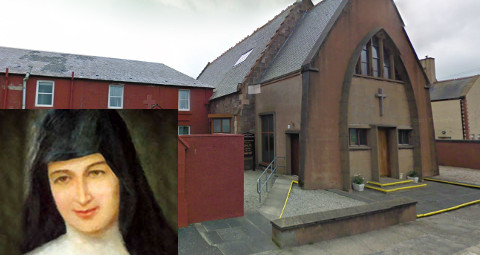May 18 | ![]() 0 COMMENTS
0 COMMENTS ![]() print
print

The giving hearts of Girvan
JOANNA MAGOUFAKIS explores the history of the Order of St Joseph of Cluny in Girvan, the Catholic community’s links to the Great Hunger, and speaks to the nuns about their mission
IN 1807, Blessed Anne Marie Javouhey founded the Order of St Joseph of Cluny in France. More than 200 years later, in the town of Girvan on the west coast of Scotland, the religious order continues to thrive despite the challenges of today.
Srs Catherine Forde, Margaret McCabe, and Ruth Nawarauckas are the only nuns from the Order remaining in Scotland. Based on Harbour Street, the nuns are a comforting presence in this seaside town renowned for having one of the best golf courses in the world and extraordinary views of Ailsa Craig. On a clear day the tip of Ireland can be seen on the horizon.
Girvan is home to a small yet faithful Catholic community that supports its only Catholic church, The Sacred Heart of Jesus and Mary, and the convent of the Sisters of St Joseph of Cluny, whose nuns are a central part of parish life.
“We are three in number, one sister in her 80s and two in their 70s; one Girvanite and two Irish sisters. Between the three of us we are religious for 162 years,” they told the SCO by email.
There have been many special occasions down the years. “There were wonderful celebrations in the parish for the centenary and bicentenary of the community and congregation. We also had several Golden Jubilees of Sisters. We had great joy in the founding of our associates and later on our SPRED group [a charity for religious development of adults with learning disabilities].”
The Catholic community in Girvan began to grow after Catholic emancipation in 1829 came to Scotland. The Irish Great Hunger (1845-1849) drove many people out of Ireland, and many came to Scotland. This mass immigration led to the growth of Catholic parishes all over the country, including Girvan, dating from the 1850s.
The presence of the Order of the Sisters of St Joseph of Cluny in Girvan dates back to 1879 when the parish priest at the time, Fr William O’Shaughnessy, requested that the sisters come over from France and establish themselves in Girvan. They would become the first Religious to settle in the town since the Reformation. They were given lodging in the then presbytery, which was later passed on to them by the parish priest.
Fr O’Shaughnessy had already started a school, in which the Sisters became teachers. Conditions were tough in Girvan at that time. People were poor and depended on casual work paid by the hour. There was also anti-Catholic prejudice, which the nuns worked very hard to overcome.
The nuns, aware of the hardships people had to endure, provided education for the Catholic children, but also cared for the orphaned and marginalised.
In 1881, the boarding school had 25 destitute and vulnerable children tended by the nuns. This vision of helping the poor and providing education are still central aspects of the mission of the nuns today.
Ss Catherine, Margaret and Ruth said: “The mission in Girvan was mainly education, both primary and secondary. At the same time all the Sisters were engaged in home and hospital visitation. Care of the poor was exercised discreetly. We belong to a worldwide missionary congregation engaged in all types of work.”
They added: “Today, we continue to do school visits. We keep contact with the Sacred Heart Primary School through assisting teachers in preparing children for the Sacraments. We also help the children to read and serve at Mass.”
In 1889, a new primary school was built in the town. Jobs were created for teaching and domestic staff. Sacred Heart Primary and secondary schools eventually became part of the state system following the 1918 Education Act. Many of the girls remained on as boarders.
A large estate at Kildonan, Barrhill, was purchased as a boarding school for juniors. The school made great progress up until 1975, when it closed due to a lack of staff and difficulty in attracting suitable teaching personnel. Sacred Heart Primary School had been transferred across the road to another building in Henrietta Street, where it is to this day.
Sacred Heart Secondary closed in 1991, but it made its mark on the community, providing many priests and Religious for the Church.
The Sisters’ original convent and the Sacred Heart school building were eventually sold and converted into flats, though the building retains some of its features including a statue of St Joseph high up on the side wall, facing down Henrietta Street. The Sisters now reside in a smaller building adjoining Sacred Heart Church, where they help run the parish.
Prayer and contemplation have always been central to the lives of Religious, and on a daily basis the nuns pray privately early in the morning. “We pray the Rosary and we also do spiritual reading,” the Sisters said. “Adoration is also a big part of our daily observance.”
When asked about how they were drawn to the monastic life, the Sisters allude to the mysterious and subtle ways God calls His people.
“We were drawn initially by the example shown by our parents and subsequently by religious and priests in schools. Unknown to us Christ was drawing us and we responded to His Grace.”
I was curious to hear how their families reacted when their daughters told them they wanted to become nuns.
“All three of us come from sound Christian families who have supported us all the years. Reactions to our calling varied. Disbelief, tears and eventually acceptance and encouragement,” they replied.
The nuns have made many sacrifices in order to be able to dedicate their lives fully to God. These include vows of solemnity, stability and poverty. However, the nuns describe their lives as deeply rewarding.
“To be a Sister in Girvan is challenging, pleasant, enriching, humbling and enabling. We receive a small budget from a central fund in the province. We do not have a personal bank account, and we receive a small monthly personal allowance.
“Through our prayer life and living in community our friendship is deepened and strengthened.”
Living together in community in the convent has helped the nuns overcome many obstacles, they said.
“Living in any small group there are challenges. Because of our prayer life and working together we support each other and should problems arise—as they can—we solve them together. Our community life is vibrant. We interact with the parishioners and the wider community. We experience mutual trust.”
The Sisters said that a nun’s life can also contain fun experiences that gives room for laughter and positive interactions with people.
“We enjoy the social celebrations in the parish. For example, we celebrate Christmas, New Year, St Andrew’s and St Patrick’s feasts, and last but not least Burns Night!”
“We also celebrate each Sister’s national feast. We use appropriate decorations on our feast days and enjoy taking part in various parish feasts.”
These inspiring women have been in the Church for almost their entire life, and needless to say, times have changed. How have those changes affected them?
“Everything has changed—one great example is the freedom to wear the ‘old habit’ or modern dress,” the nuns said, adding that the other major change is the fall in numbers. “We now have only one house in Scotland, whereas in the past we had six,” they said.
Although it is difficult to predict what the future holds for the convent it is clear it will continue to be an important part of Girvan and the life of the Church.











